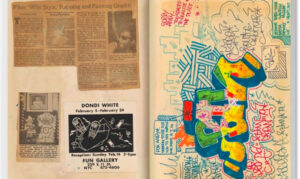The release of ZEPHYR’s “Graffiti Black Book/Scrapbook: 1978 & Beyond” marks a pivotal moment in the world of graffiti and street art. For decades, graffiti has been a defining visual language of urban culture, shaping the aesthetic of cityscapes and influencing generations of artists. This highly anticipated sketchbook serves as a time capsule, preserving the raw creativity, rebellious spirit, and artistic evolution that flourished during the late 1970s and 1980s in New York City.
As one of the early pioneers of graffiti, ZEPHYR played an instrumental role in developing the movement, contributing to its rise from underground subculture to a recognized form of artistic expression. His latest publication offers an intimate, behind-the-scenes glimpse into his journey, chronicling the sketches, tags, and creative processes that laid the foundation for a global artistic revolution.
With contributions from other legendary figures such as MACKIE and BIL-ROCK, this book is not only a reflection of ZEPHYR’s personal legacy but also a tribute to the entire graffiti community. It provides an invaluable resource for fans, historians, and aspiring artists seeking to understand the origins and progression of graffiti art.
The Evolution of Graffiti: A Cultural Revolution
Graffiti, as we recognize it today, took root in 1970s New York City, where artists used subway cars and walls as their canvases. This movement, born out of youthful expression and defiance, transformed the visual landscape of the city, creating an entirely new artistic language. At its core, graffiti was an act of reclaiming public space, a way for marginalized communities to make their voices heard.
By the late 1970s and early 1980s, graffiti had evolved into a complex and highly stylized art form. Writers competed for visibility, perfecting their lettering styles, color schemes, and intricate designs. It was during this time that ZEPHYR emerged as one of the defining figures of the movement, developing a unique style that would influence countless artists to come.
ZEPHYR’s work was not just about aesthetics—it was about storytelling. Each piece was a declaration, a mark of identity, and a contribution to a rapidly growing subculture. Through “Graffiti Black Book/Scrapbook: 1978 & Beyond,” he provides an unfiltered look at his artistic journey and the evolution of graffiti from its raw beginnings to an internationally celebrated art form.
Inside the Graffiti Black Book/Scrapbook
This sketchbook is more than just a collection of drawings—it is a visual diary of an era. The pages of “Graffiti Black Book/Scrapbook” are filled with ZEPHYR’s early sketches, concept designs, and lettering experiments, offering an unprecedented look at the creative process behind some of the most iconic graffiti works of the time.
Key Features of the Book:
• Unreleased Sketches & Concepts: The book contains original sketches from ZEPHYR’s archives, many of which have never been publicly shared before.
• Historical Context: The artwork is accompanied by personal notes, anecdotes, and reflections on the evolution of graffiti culture.
• Flows with Graffiti Legends: Contributions from MACKIE, BIL-ROCK, and other prominent graffiti writers add depth to the book, showcasing the diversity of styles that shaped the movement.
• Authentic NYC Graffiti Culture: The pages reflect the artistic environment of New York’s streets and subways, capturing the raw energy and rebellious spirit of the time.
This book serves as a bridge between past and present, allowing readers to immerse themselves in the foundational years of street art while also recognizing its lasting influence.
ZEPHYR’s Influence on Graffiti Culture
ZEPHYR is widely regarded as one of the key figures in bringing graffiti from the streets into the realm of fine art. His work has been displayed in galleries and museums, proving that graffiti is more than just vandalism—it is a legitimate and powerful art form.
From Subway Cars to Galleries
ZEPHYR began his graffiti journey by painting on subway trains, a practice that defined the movement in the late 1970s and early 1980s. His pieces stood out for their precision, bold lettering, and creative use of space. Over time, his reputation grew, and his work caught the attention of the art world.
By the mid-1980s, graffiti had begun to transition from the streets into galleries, and ZEPHYR was among the artists leading this shift. His ability to adapt his style while maintaining the core essence of graffiti allowed him to thrive in both underground and institutional settings.
Legacy & Impression
ZEPHYR’s influence extends far beyond his own work. He has mentored younger graffiti artists, contributed to numerous documentaries and books on the subject, and remains a respected voice in the graffiti community. His involvement in projects like “Graffiti Black Book/Scrapbook” ensures that the history of graffiti is preserved and appreciated by new generations.
The Importance of Documenting Graffiti History
For many years, graffiti was dismissed as vandalism, leading to the destruction of countless masterpieces. However, as time has passed, the art world has come to recognize graffiti’s cultural significance. Books like “Graffiti Black Book/Scrapbook” play a crucial role in preserving this history, ensuring that the contributions of pioneering artists are not forgotten.
This documentation is particularly important because many original graffiti works no longer exist. Subway cars have been repainted, walls have been torn down, and city policies have aggressively targeted graffiti removal. By compiling these sketches and stories, ZEPHYR is safeguarding an art form that might otherwise fade into obscurity.
Why This Book Matters Today
Graffiti has come a long way since its early days in New York City. What was once an underground movement has now influenced fashion, music, advertising, and mainstream art. Today, artists like Banksy, Shepard Fairey, and KAWS have built global careers using graffiti-inspired aesthetics.
However, despite its widespread recognition, graffiti still faces challenges. Many cities continue to enforce harsh anti-graffiti laws, and the debate over street art vs. vandalism remains ongoing. By revisiting the roots of the movement through ZEPHYR’s sketchbook, readers can gain a deeper appreciation for the cultural and artistic value of graffiti.
Final Thoughts: A Must-Have for Graffiti Enthusiasts
“Graffiti Black Book/Scrapbook: 1978 & Beyond” is more than just a book—it’s a historical artifact. It offers an authentic look at the birth and evolution of graffiti, featuring the work of one of its most influential pioneers.
For graffiti artists, collectors, and art historians, this book is an essential addition to their collection. It serves as a reminder of the power of street art and the artists who shaped it. More importantly, it highlights the resilience of a movement that continues to thrive despite decades of challenges.
With ZEPHYR at the helm, this sketchbook provides an intimate, first-hand perspective on the graffiti explosion of the late 20th century. Whether you’re an aspiring graffiti writer, a longtime fan of street art, or someone interested in urban culture, this book is a must-read.
Now available for purchase, “Graffiti Black Book/Scrapbook: 1978 & Beyond” offers the unique opportunity to own a piece of street art history. Don’t miss out on this chance to explore the sketches, stories, and styles that helped define one of the most dynamic art movements of our time.
No comments yet.









